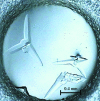Preliminary crystallographic studies of purine nucleoside phosphorylase from the cariogenic pathogen Streptococcus mutans
- PMID: 20054131
- PMCID: PMC2802883
- DOI: 10.1107/S1744309109045059
Preliminary crystallographic studies of purine nucleoside phosphorylase from the cariogenic pathogen Streptococcus mutans
Abstract
The punA gene of the cariogenic pathogen Streptococcus mutans encodes purine nucleoside phosphorylase (PNP), which is a pivotal enzyme in the nucleotide-salvage pathway, catalyzing the phosphorolysis of purine nucleosides to generate purine bases and alpha-ribose 1-phosphate. In the present work, the PNP protein was expressed in Escherichia coli strain BL21 (DE3) in a soluble form at a high level. After purification of the PNP enzyme, the protein was crystallized using the sitting-drop vapour-diffusion technique; the crystals diffracted to 1.6 A resolution at best. The crystals belonged to space group H3, with unit-cell parameters a = b = 113.0, c = 60.1 A.
Figures


Similar articles
-
Protein preparation, crystallization and preliminary X-ray crystallographic analysis of SMU.961 protein from the caries pathogen Streptococcus mutans.Acta Crystallogr Sect F Struct Biol Cryst Commun. 2007 Oct 1;63(Pt 10):882-3. doi: 10.1107/S1744309107043242. Epub 2007 Sep 19. Acta Crystallogr Sect F Struct Biol Cryst Commun. 2007. PMID: 17909295 Free PMC article.
-
Crystal structure of Escherichia coli purine nucleoside phosphorylase in complex with 7-deazahypoxanthine.Acta Crystallogr F Struct Biol Commun. 2018 Jun 1;74(Pt 6):355-362. doi: 10.1107/S2053230X18006337. Epub 2018 May 23. Acta Crystallogr F Struct Biol Commun. 2018. PMID: 29870020 Free PMC article.
-
Crystallization and preliminary X-ray crystallographic analysis of SMU.412c protein from the caries pathogen Streptococcus mutans.Acta Crystallogr Sect F Struct Biol Cryst Commun. 2009 Apr 1;65(Pt 4):392-4. doi: 10.1107/S1744309109009464. Epub 2009 Mar 25. Acta Crystallogr Sect F Struct Biol Cryst Commun. 2009. PMID: 19342789 Free PMC article.
-
Structural analyses reveal two distinct families of nucleoside phosphorylases.Biochem J. 2002 Jan 1;361(Pt 1):1-25. doi: 10.1042/0264-6021:3610001. Biochem J. 2002. PMID: 11743878 Free PMC article. Review.
-
Chemo-Enzymatic Generation of Highly Fluorescent Nucleoside Analogs Using Purine-Nucleoside Phosphorylase.Biomolecules. 2024 Jun 14;14(6):701. doi: 10.3390/biom14060701. Biomolecules. 2024. PMID: 38927104 Free PMC article. Review.
Cited by
-
NupR Responding to Multiple Signals Is a Nucleoside Permease Regulator in Bacillus thuringiensis BMB171.Microbiol Spectr. 2022 Aug 31;10(4):e0154322. doi: 10.1128/spectrum.01543-22. Epub 2022 Jul 7. Microbiol Spectr. 2022. PMID: 35862946 Free PMC article.
References
-
- Bennett, L. L. Jr, Allan, P. W., Noker, P. E., Rose, L. M., Niwas, S., Montgomery, J. A. & Erion, M. D. (1993). J. Pharmacol. Exp. Ther.266, 707–714. - PubMed
-
- Bzowska, A., Kulikowska, E. & Shugar, D. (2000). Pharmacol. Ther.88, 349–425. - PubMed
-
- Bzowska, A., Luić, M., Schröder, W., Shugar, D., Saenger, W. & Koellner, G. (1995). FEBS Lett.367, 214–218. - PubMed
-
- Collaborative Computational Project, Number 4 (1994). Acta Cryst. D50, 760–763. - PubMed
-
- Ealick, S. E., Rule, S. A., Carter, D. C., Greenhough, T. J., Babu, Y. S., Cook, W. J., Habash, J., Helliwell, J. R., Stoeckler, J. D., Parks, R. E. Jr, Chen, S. & Bugg, C. E. (1990). J. Biol. Chem.265, 1812–1820. - PubMed
Publication types
MeSH terms
Substances
LinkOut - more resources
Full Text Sources
Miscellaneous

